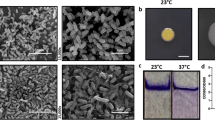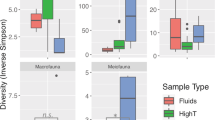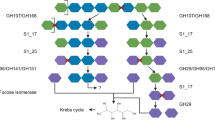Abstract
REPEATED freezing and thawing of bacteria is generally considered to be lethal1,2, but Aerobacter aerogenes and a Pseudomonas species have survived and grown well in experiments simulating Martian temperature extremes of about +25° C to −75° C (ref. 3). The bacteria spent only about 4.5 h above 0° C with a maximum near 25° C in each 24 h cycle. Growth rates in liquid media were found to be comparable with the non-cycled controls held at 25° C. In similar work with desert algal-lichen soil crusts4, the algae survived repeated freezing and thawing but did not grow during the treatment. The algae were grown later on a modified Pochon solution incubated at 27° C–30° C. The diurnal temperature extremes were −79° C or −195° C for 15 h and 22° C for 9 h for periods of 1–7 days. As far as is known, no comparable work has been done on the response of fungi to diurnal temperature extremes.
This is a preview of subscription content, access via your institution
Access options
Subscribe to this journal
Receive 51 print issues and online access
$199.00 per year
only $3.90 per issue
Buy this article
- Purchase on SpringerLink
- Instant access to full article PDF
Prices may be subject to local taxes which are calculated during checkout
Similar content being viewed by others
References
Smith, A. U., Biological Effects of Freezing and Supercooling (Williams and Wilkins Co., 1961).
Lamanna, C., and Mallette, M. F., Basic Bacteriology (Williams and Wilkins Co., 1965).
Young, R. S., Deal, P. H., Bell, J., and Allen, J. L., Life Sciences and Space Research II (edit. by Florkin, M., and Dolfus, A.) (North-Holland Publishing Co., Amsterdam, 1964).
Cameron, R. E., and Blank, G. B., Space Program Summaries No. 37, vol. 4 (Jet Propulsion Laboratory, Pasadena, California, 1966).
Gehenio, P. M., and Luyet, B. J., Biodynamica, 55, 1 (1939).
Mazur, P., Fed. Proc., 24, 175 (1965).
Author information
Authors and Affiliations
Rights and permissions
About this article
Cite this article
CURTIS, C. Response of Fungi to Diurnal Temperature Extremes. Nature 213, 738–739 (1967). https://doi.org/10.1038/213738a0
Received:
Issue date:
DOI: https://doi.org/10.1038/213738a0
This article is cited by
-
Testing and evaluation of natural durability of wood in above ground conditions in Europe – an overview
Journal of Wood Science (2005)
-
Mycology studies in space
Mycopathologia (1990)
-
Indicator organisms in frozen foods in relation to spoilage
Antonie van Leeuwenhoek (1983)
-
Space-related research in mycology concurrent with the first decade of manned space exploration
Space Life Sciences (1973)



